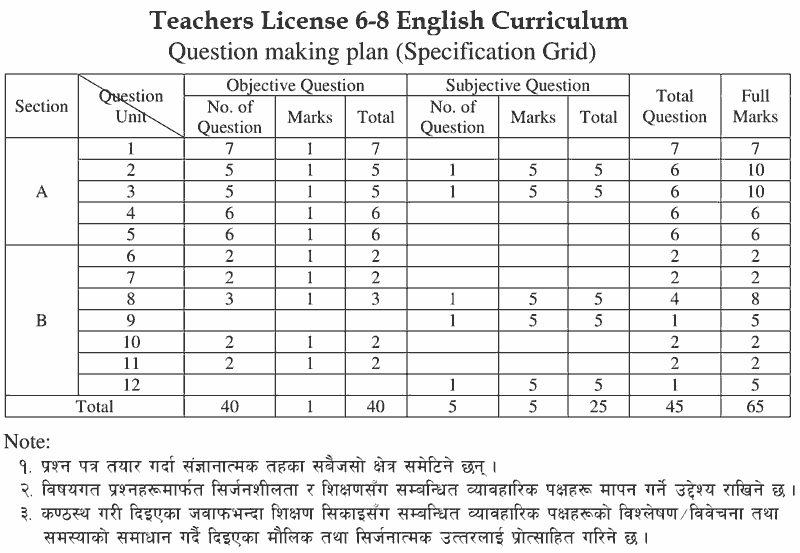
Government of Nepal, Teacher Service Commission
Teacher Licensing Curriculum for Lower Secondary Teacher, 2075
Section B: English
Introduction
This curriculum has been developed in order to test competencies required for a potential English language teacher for grades six to eight. The content areas cover the knowledge and skills of the English language as well as the ability to use various instructional strategies and modern technology including ICT in the field of English language teaching. This paper carries 65 marks that comprise of 40 objective questions each carrying 1 mark and 5 long questions carrying 5 marks as per the specification grid. The content covered is based on the required competencies in accordance with the Teacher Competency Framework, 2072 as well as the curriculum of academic and professional qualification required as a minimum for this level.
Objective
The overall objective of this curriculum is to test whether the teacher candidates meet the minimum requirement and possess the competencies needed to become an English teacher for grade 6 to 8 so that selection of a qualified and competent teacher can be ensured.
A. Content knowledge
1. English language teaching in Nepal
1.1 Understanding the need and importance of learning English
1.2 Learning English as a second/foreign language
2. Introduction to language skills and aspects
2.1 Language skills: Listening, speaking, reading and writing
2.2 Aspects: vocabulary, grammar
3. Language functions
3.1 Defining language functions
3.2 Types of language functions
4. Written communication in English
4.1 Letter
4.2 Invitation
4.3 Condolence
4.4 Gratitude
4.5 Congratulation
4.6 Paragraph
5. Genre in Literature
5.1 Prose: Essay, short story
5.2 Poetry
5.3 Drama
B. Pedagogical knowledge and skills
6. The current 6-8 English curriculum
6.1 Focus and organization
6.2Competencies and learning outcomes
6.3 Horizontal and vertical linkage
7. Approaches to teaching English
7.1 Traditional approaches
7.2 Modern approaches
7.3 Communicative approach
8. Teaching language skills
8.1 Teaching listening
8.1.1 What is listening and what makes it difficult?
8.1.2 Listening comprehension
8.1.3 Teaching listening: techniques, tasks, and teaching materials
8.1.4 Assessing listening: tools and techniques
8.2 Teaching Speaking
8.2.1 Components of speaking: pronunciation, stress, intonation
8.2.2 Tasks and activities for developing communicative skills
8.2.3 Teaching pronunciation: techniques, tasks, and teaching materials
8.2.4 Fluency and accuracy
8.2.5 Teaching language functions
8.2.6 Assessing speaking: tools and techniques
8.3 Teaching Reading
8.3.1 Reading: what and why?
8.3.2 Scanning, skimming, extensive and intensive reading
8.3.3 Reading comprehension
8.3.4 Teaching reading: techniques, tasks, and teaching materials
8.3.5 Assessing reading: tools and techniques
8.4 Teaching writing
8.4.1 Writing and its components
8.4.2 Writing activities at a basic level
8.4.3 Assessing writing: tools and techniques
9. Teaching Language aspects
9.1 Teaching vocabulary
9.1.1 Vocabulary and its aspects: form, meaning, grammar, use
9.1.2 Techniques of teaching word meaning
9.1.3 Teaching vocabulary: techniques, tasks, and teaching materials
9.1.4 Assessing vocabulary: tools and techniques
9.2 Teaching Grammar
9.2.1 Teaching grammar in context
9.2.2 Teaching grammar: techniques, tasks, and teaching materials
9.2.3 Assessing grammar: tools and techniques
10 Teaching literature
10.1 Teaching short stories and essays
10.2 Teaching poetry
10.3 Teaching drama
11. Teaching language in the changed era
11.1 Innovative teaching practices for enhanced learning
11.2 Use of relevant technology including ICT in teaching English
12. Instructional planning
12.1 Annual and unit plans for curriculum implementation
12.2 Planning daily lessons
Question making plan (Specification Grid)
|
Section |
Question Units |
Objective Question |
Subjective Question |
Total Question |
Full Marks |
||||
|
No. of Question |
Marks |
Total |
No. of Question |
Marks |
Total |
||||
|
A |
1 |
7 |
1 |
7 |
|
|
|
7 |
7 |
|
2 |
5 |
1 |
5 |
1 |
5 |
5 |
6 |
10 |
|
|
3 |
5 |
1 |
5 |
1 |
5 |
5 |
6 |
10 |
|
|
4 |
6 |
1 |
6 |
|
|
|
6 |
6 |
|
|
5 |
6 |
1 |
6 |
|
|
|
6 |
6 |
|
|
B |
6 |
2 |
1 |
2 |
|
|
|
2 |
2 |
|
7 |
2 |
1 |
2 |
|
|
|
2 |
2 |
|
|
8 |
3 |
1 |
3 |
1 |
5 |
5 |
4 |
8 |
|
|
9 |
|
|
|
1 |
5 |
5 |
1 |
5 |
|
|
10 |
2 |
1 |
2 |
|
|
|
2 |
2 |
|
|
11 |
2 |
1 |
2 |
|
|
|
2 |
|
|
|
12 |
|
|
|
1 |
5 |
5 |
1 |
5 |
|
|
Total |
40 |
1 |
40 |
5 |
5 |
25 |
45 |
65 |
|
Please Download Collegenp Apps from Playstore: Install Now for regular Update




